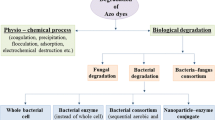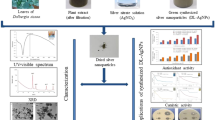Abstract
This study reveals the feasibility of exploring highly efficient, cost-effective, and stable green adsorbents for the treatment of contaminated water. Here silver nanoparticles (AgNPs) were immobilized onto nanosheets of graphene oxide (GO) through in situ reduction process using green tea aqueous extract. GO reduction to reduced graphene oxide (rGO) and AgNPs decoration on rGO also occurred simultaneously. The impacts of the extract concentration, contact time, and temperature on the synthesis process have been investigated. The synthesized nanocomposites were examined by XRD, FTIR, Raman, SEM, TEM, and TGA. The GO nanosheets were decorated by AgNPs with a crystalline structure and an average particle size of 25 ± 3 nm. The temperature and the extract concentration were considerably affecting the type of the resulting nanocomposites. The GO/Ag nanocomposites were formed at room temperature (27 °C) using different extract concentration (2–18% (v/v)), while the rGO/Ag nanocomposite was formed only at a higher temperature (95 °C) with higher extract concentration (18%). The methylene blue (MB) dye was picked as a water pollutant to explore the adsorption ability of the nanocomposites. The adsorption behavior of the GO/Ag nanocomposites was examined under diverse factors (MB concentration, adsorbent dosage, pH, and contact time) to achieve optimization. The adsorption data concurs with Langmuir isotherm giving maximum adsorption up to 633 mg g−1. Adsorption kinetics demonstrate good pseudo-second-order compliance. Spontaneous and endothermic nature of adsorption was affirmed via thermodynamic parameters. The nanocomposites could be utilized as eco-friendly and reliable adsorbents in wastewater treatment, as a result of their exceptional productivity and reusing potential.











Similar content being viewed by others
References
Abboud, M., Sahlabji, T., Haija, M. A., El-Zahhar, A. A., Bondock, S., Ismail, I., et al. (2020). Synthesis and characterization of lignosulfonate/amino-functionalized SBA-15 nanocomposites for the adsorption of methylene blue from wastewater. New Journal of Chemistry, 44(6), 2291–2302.
Aboelfetoh, E. F., El-Shenody, R. A., & Ghobara, M. M. (2017). Eco-friendly synthesis of silver nanoparticles using green algae (Caulerpa serrulata): Reaction optimization, catalytic and antibacterial activities. Environmental Monitoring and Assessment, 189(7), 349.
Aboelfetoh, E. F., Elhelaly, A. A., & Gemeay, A. H. (2018). Synergistic effect of Cu (II) in the one-pot synthesis of reduced graphene oxide (rGO/CuxO) nanohybrids as adsorbents for cationic and anionic dyes. Journal of Environmental Chemical Engineering, 6(1), 623–634.
Aboubaraka, A. E., Aboelfetoh, E. F., & Ebeid, E.-Z. M. (2017). Coagulation effectiveness of graphene oxide for the removal of turbidity from raw surface water. Chemosphere, 181, 738–746.
Agnihotri, S., Mukherji, S., & Mukherji, S. (2014). Size-controlled silver nanoparticles synthesized over the range 5–100 nm using the same protocol and their antibacterial efficacy. RSC Advances, 4(8), 3974–3983.
Ahmadzadeh Tofighy, M., & Mohammadi, T. (2014). Methylene blue adsorption onto granular activated carbon prepared from Harmal seeds residue. Desalination and Water Treatment, 52(13–15), 2643–2653.
Allen, H. J., Impellitteri, C. A., Macke, D. A., Heckman, J. L., Poynton, H. C., Lazorchak, J. M., Govindaswamy, S., Roose, D. L., & Nadagouda, M. N. (2010). Effects from filtration, capping agents, and presence/absence of food on the toxicity of silver nanoparticles to Daphnia magna. Environmental Toxicology and Chemistry, 29(12), 2742–2750.
Beyene, H. D., Werkneh, A. A., Bezabh, H. K., & Ambaye, T. G. (2017). Synthesis paradigm and applications of silver nanoparticles (AgNPs), a review. Sustainable Materials and Technologies, 13, 18–23.
Chieng, H. I., Priyantha, N., & Lim, L. B. (2015). Effective adsorption of toxic brilliant green from aqueous solution using peat of Brunei Darussalam: Isotherms, thermodynamics, kinetics and regeneration studies. RSC Advances, 5(44), 34603–34615.
Chook, S. W., Chia, C. H., Zakaria, S., Ayob, M. K., Chee, K. L., Huang, N. M., et al. (2012). Antibacterial performance of Ag nanoparticles and AgGO nanocomposites prepared via rapid microwave-assisted synthesis method. Nanoscale Research Letters, 7(1), 1–7.
de Moraes, A. C. M., Lima, B. A., de Faria, A. F., Brocchi, M., & Alves, O. L. (2015). Graphene oxide-silver nanocomposite as a promising biocidal agent against methicillin-resistant Staphylococcus aureus. International Journal of Nanomedicine, 10, 6847.
Długosz, O., Chwastowski, J., & Banach, M. (2020). Hawthorn berries extract for the green synthesis of copper and silver nanoparticles. Chemical Papers, 74(1), 239–252.
Dotto, G., dos Santos, J. N., Rosa, R., Pinto, L., Pavan, F., & Lima, E. (2015). Fixed bed adsorption of methylene blue by ultrasonic surface modified chitin supported on sand. Chemical Engineering Research and Design, 100, 302–310.
Dubale, A. A., Su, W.-N., Tamirat, A. G., Pan, C.-J., Aragaw, B. A., Chen, H.-M., et al. (2014). The synergetic effect of graphene on Cu 2 O nanowire arrays as a highly efficient hydrogen evolution photocathode in water splitting. Journal of Materials Chemistry A, 2(43), 18383–18397.
El-Sharkaway, E., Kamel, R. M., El-Sherbiny, I. M., & Gharib, S. S. (2019). Removal of methylene blue from aqueous solutions using polyaniline/graphene oxide or polyaniline/reduced graphene oxide composites. Environmental Technology, (just-accepted), 1-35
Ferrero, F. (2010). Adsorption of methylene blue on magnesium silicate: Kinetics, equilibria and comparison with other adsorbents. Journal of Environmental Sciences, 22(3), 467–473.
Fujiki, H., Watanabe, T., Sueoka, E., Rawangkan, A., & Suganuma, M. (2018). Cancer prevention with green tea and its principal constituent, EGCG: From early investigations to current focus on human cancer stem cells. Molecules and Cells, 41(2), 73–82.
Gao, J. J., Qin, Y. B., Zhou, T., Cao, D. D., Xu, P., Hochstetter, D., & Wang, Y. F. (2013). Adsorption of methylene blue onto activated carbon produced from tea (Camellia sinensis L.) seed shells: Kinetics, equilibrium, and thermodynamics studies. Journal of Zhejiang University. Science. B, 14(7), 650–658. https://doi.org/10.1631/jzus.B12a0225.
Gemeay, A. H., Aboelfetoh, E. F., & El-Sharkawy, R. G. (2018a). Immobilization of green synthesized silver nanoparticles onto amino-functionalized silica and their application for indigo carmine dye removal. Water, Air, & Soil Pollution, 229(1), 16.
Gemeay, A. H., Elsharkawy, R. G., & Aboelfetoh, E. F. (2018b). Graphene oxide/polyaniline/manganese oxide ternary nanocomposites, facile synthesis, characterization, and application for indigo carmine removal. Journal of Polymers and the Environment, 26(2), 655–669.
Ghaedi, M., Sadeghian, B., Pebdani, A. A., Sahraei, R., Daneshfar, A., & Duran, C. (2012). Kinetics, thermodynamics and equilibrium evaluation of direct yellow 12 removal by adsorption onto silver nanoparticles loaded activated carbon. Chemical Engineering Journal, 187, 133–141.
Haldorai, Y., Kim, B.-K., Jo, Y.-L., & Shim, J.-J. (2014). Ag@ graphene oxide nanocomposite as an efficient visible-light plasmonic photocatalyst for the degradation of organic pollutants: A facile green synthetic approach. Materials Chemistry and Physics, 143(3), 1452–1461.
Haque, S., Gain, S., Gupta, K., & Ghosh, U. C. (2019). Methylene blue (a cationic dye) adsorption performance of graphene oxide fabricated Fe-Al bimetal oxide composite from water. Water Quality Research Journal, 54(1), 57–69.
Hashemi, F., Tasharrofi, N., & Saber, M. M. (2020). Green synthesis of silver nanoparticles using Teucrium polium leaf extract and assessment of their antitumor effects against MNK45 human gastric cancer cell line. Journal of Molecular Structure, 127889.
Hebeish, A., El-Rafie, M., Abdel-Mohdy, F., Abdel-Halim, E., & Emam, H. E. (2010). Carboxymethyl cellulose for green synthesis and stabilization of silver nanoparticles. Carbohydrate Polymers, 82(3), 933–941.
Hegyesi, N., Vad, R. T., & Pukánszky, B. (2017). Determination of the specific surface area of layered silicates by methylene blue adsorption: The role of structure, pH and layer charge. Applied Clay Science, 146, 50–55.
Heidarizad, M., & Şengör, S. S. (2016). Synthesis of graphene oxide/magnesium oxide nanocomposites with high-rate adsorption of methylene blue. Journal of Molecular Liquids, 224, 607–617.
Hou, C., Zhang, Q., Wang, H., & Li, Y. (2011). Functionalization of PNIPAAm microgels using magnetic graphene and their application in microreactors as switch materials. Journal of Materials Chemistry, 21(28), 10512–10517.
Hou, I.-C., Amarnani, S., Chong, M. T., & Bishayee, A. (2013). Green tea and the risk of gastric cancer: Epidemiological evidence. World Journal of Gastroenterology, 19(24), 3713–3722.
Huang, J., Zhang, L., Chen, B., Ji, N., Chen, F., Zhang, Y., & Zhang, Z. (2010). Nanocomposites of size-controlled gold nanoparticles and graphene oxide: Formation and applications in SERS and catalysis. Nanoscale, 2(12), 2733–2738.
Huang, N., Lim, H., Chia, C. H., Yarmo, M. A., & Muhamad, M. (2011). Simple room-temperature preparation of high-yield large-area graphene oxide. International Journal of Nanomedicine, 6, 3443.
Huang, L., Yang, H., Zhang, Y., & Xiao, W. (2016). Study on synthesis and antibacterial properties of Ag NPs/GO nanocomposites. Journal of Nanomaterials, 2016.
Ismail, M. (2020). Green synthesis and characterizations of copper nanoparticles. Materials Chemistry and Physics, 240, 122283.
Konicki, W., Aleksandrzak, M., & Mijowska, E. (2017). Equilibrium, kinetic and thermodynamic studies on adsorption of cationic dyes from aqueous solutions using graphene oxide. Chemical Engineering Research and Design, 123, 35–49.
Kooh, M. R. R., Lim, L. B., Lim, L. H., & Dahri, M. K. (2016). Separation of toxic rhodamine B from aqueous solution using an efficient low-cost material, Azolla pinnata, by adsorption method. Environmental Monitoring and Assessment, 188(2), 1–15.
Kumar, S. V., Huang, N. M., Lim, H. N., Marlinda, A., Harrison, I., & Chia, C. H. (2013). One-step size-controlled synthesis of functional graphene oxide/silver nanocomposites at room temperature. Chemical Engineering Journal, 219, 217–224.
Lee, S. H., & Jun, B.-H. (2019). Silver nanoparticles: Synthesis and application for nanomedicine. International Journal of Molecular Sciences, 20(4), 865.
Lee, L.-S., Kim, S.-H., Kim, Y.-B., & Kim, Y.-C. (2014). Quantitative analysis of major constituents in green tea with different plucking periods and their antioxidant activity. Molecules, 19(7), 9173–9186.
Li, L., Liu, X. L., Geng, H. Y., Hu, B., Song, G. W., & Xu, Z. S. (2013a). A MOF/graphite oxide hybrid (MOF: HKUST-1) material for the adsorption of methylene blue from aqueous solution. Journal of Materials Chemistry A, 1(35), 10292–10299.
Li, Y., Du, Q., Liu, T., Sun, J., Wang, Y., Wu, S., et al. (2013b). Methylene blue adsorption on graphene oxide/calcium alginate composites. Carbohydrate Polymers, 95(1), 501–507.
Lightcap, I. V., Kosel, T. H., & Kamat, P. V. (2010). Anchoring semiconductor and metal nanoparticles on a two-dimensional catalyst mat. Storing and shuttling electrons with reduced graphene oxide. Nano Letters, 10(2), 577–583.
Liu, C.-C., Xu, H., Wang, L., & Qin, X. (2017). Facile one-pot green synthesis and antibacterial activities of GO/Ag nanocomposites. Acta Metallurgica Sinica (English Letters), 30(1), 36–44.
Madrakian, T., Afkhami, A., Ahmadi, M., & Bagheri, H. (2011). Removal of some cationic dyes from aqueous solutions using magnetic-modified multi-walled carbon nanotubes. Journal of Hazardous Materials, 196, 109–114.
Mahmoud, M. E., Amira, M. F., Seleim, S. M., & Mohamed, A. K. (2017). Adsorption isotherm models, kinetics study, and thermodynamic parameters of Ni (II) and Zn (II) removal from water using the LbL technique. Journal of Chemical & Engineering Data, 62(2), 839–850.
Marrakchi, F., Khanday, W., Asif, M., & Hameed, B. (2016). Cross-linked chitosan/sepiolite composite for the adsorption of methylene blue and reactive orange 16. International Journal of Biological Macromolecules, 93, 1231–1239.
Martínez-Orozco, R., Rosu, H., Lee, S.-W., & Rodríguez-González, V. (2013). Understanding the adsorptive and photoactivity properties of Ag-graphene oxide nanocomposites. Journal of Hazardous Materials, 263, 52–60.
Maruthapandi, M., Eswaran, L., Luong, J. H., & Gedanken, A. (2020). Sonochemical preparation of polyaniline@ TiO2 and polyaniline@ SiO2 for the removal of anionic and cationic dyes. Ultrasonics Sonochemistry, 62, 104864.
Montes-Navajas, P., Asenjo, N. G., Santamaría, R., Menendez, R., Corma, A., & García, H. (2013). Surface area measurement of graphene oxide in aqueous solutions. Langmuir, 29(44), 13443–13448.
Nasrullah, A., Bhat, A., Naeem, A., Isa, M. H., & Danish, M. (2018). High surface area mesoporous activated carbon-alginate beads for efficient removal of methylene blue. International Journal of Biological Macromolecules, 107, 1792–1799.
Pal, U., Sandoval, A., Madrid, S. I. U., Corro, G., Sharma, V., & Mohanty, P. (2016). Mixed titanium, silicon, and aluminum oxide nanostructures as novel adsorbent for removal of rhodamine 6G and methylene blue as cationic dyes from aqueous solution. Chemosphere, 163, 142–152.
Razzaque, S., Hussain, S. Z., Hussain, I., & Tan, B. (2016). Design and utility of metal/metal oxide nanoparticles mediated by thioether end-functionalized polymeric ligands. Polymers, 8(4), 156.
Rolim, W. R., Pelegrino, M. T., de Araújo Lima, B., Ferraz, L. S., Costa, F. N., Bernardes, J. S., et al. (2019). Green tea extract mediated biogenic synthesis of silver nanoparticles: Characterization, cytotoxicity evaluation and antibacterial activity. Applied Surface Science, 463, 66–74.
Rónavári, A., Kovács, D., Igaz, N., Vágvölgyi, C., Boros, I. M., Kónya, Z., et al. (2017). Biological activity of green-synthesized silver nanoparticles depends on the applied natural extracts: A comprehensive study. International Journal of Nanomedicine, 12, 871.
Saini, J., Garg, V., & Gupta, R. (2018). Removal of methylene blue from aqueous solution by Fe3O4@ Ag/SiO2 nanospheres: Synthesis, characterization and adsorption performance. Journal of Molecular Liquids, 250, 413–422.
Saiphaneendra, B., Saxena, T., Singh, S. A., Madras, G., & Srivastava, C. (2017). Synergistic effect of co-existence of hematite (α-Fe2O3) and magnetite (Fe3O4) nanoparticles on graphene sheet for dye adsorption. Journal of Environmental Chemical Engineering, 5(1), 26–37.
Salem, W., Leitner, D. R., Zingl, F. G., Schratter, G., Prassl, R., Goessler, W., et al. (2015). Antibacterial activity of silver and zinc nanoparticles against Vibrio cholerae and enterotoxic Escherichia coli. International Journal of Medical Microbiology, 305(1), 85–95.
Sang, S., Li, D., Zhang, H., Sun, Y., Jian, A., Zhang, Q., et al. (2017). Facile synthesis of AgNPs on reduced graphene oxide for highly sensitive simultaneous detection of heavy metal ions. RSC Advances, 7(35), 21618–21624.
Sengupta, A., Mallick, S., & Bahadur, D. (2017). Tetragonal nanostructured zirconia modified hematite mesoporous composite for efficient adsorption of toxic cations from wastewater. Journal of Environmental Chemical Engineering, 5(5), 5285–5292.
Shao, Y., Wang, X., Kang, Y., Shu, Y., Sun, Q., & Li, L. (2014). Application of Mn/MCM-41 as an adsorbent to remove methyl blue from aqueous solution. Journal of Colloid and Interface Science, 429, 25–33.
Shao, W., Liu, X., Min, H., Dong, G., Feng, Q., & Zuo, S. (2015). Preparation, characterization, and antibacterial activity of silver nanoparticle-decorated graphene oxide nanocomposite. ACS Applied Materials & Interfaces, 7(12), 6966–6973.
Sharma, P., Hussain, N., Borah, D. J., & Das, M. R. (2013). Kinetics and adsorption behavior of the methyl blue at the graphene oxide/reduced graphene oxide nanosheet–water interface: A comparative study. Journal of Chemical & Engineering Data, 58(12), 3477–3488.
Sobon, G., Sotor, J., Jagiello, J., Kozinski, R., Zdrojek, M., Holdynski, M., Paletko, P., Boguslawski, J., Lipinska, L., & Abramski, K. M. (2012). Graphene oxide vs. reduced graphene oxide as saturable absorbers for Er-doped passively mode-locked fiber laser. Optics Express, 20(17), 19463–19473.
Sun, Q., Cai, X., Li, J., Zheng, M., Chen, Z., & Yu, C.-P. (2014). Green synthesis of silver nanoparticles using tea leaf extract and evaluation of their stability and antibacterial activity. Colloids and Surfaces A: Physicochemical and Engineering Aspects, 444, 226–231.
Tang, X.-Z., Li, X., Cao, Z., Yang, J., Wang, H., Pu, X., et al. (2013). Synthesis of graphene decorated with silver nanoparticles by simultaneous reduction of graphene oxide and silver ions with glucose. Carbon, 59, 93–99.
Van Tran, T., Nguyen, D. T. C., Le, H. T., Duong, C. D., Bach, L. G., Nguyen, H.-T. T., et al. (2019). Facile synthesis of manganese oxide-embedded mesoporous carbons and their adsorbability towards methylene blue. Chemosphere, 227, 455–461.
Vi, T. T. T., Rajesh Kumar, S., Rout, B., Liu, C.-H., Wong, C.-B., Chang, C.-W., et al. (2018). The preparation of graphene oxide-silver nanocomposites: The effect of silver loads on gram-positive and gram-negative antibacterial activities. Nanomaterials, 8(3), 163.
Vidhu, V., & Philip, D. (2014). Catalytic degradation of organic dyes using biosynthesized silver nanoparticles. Micron, 56, 54–62.
Wang, P., Cao, M., Wang, C., Ao, Y., Hou, J., & Qian, J. (2014). Kinetics and thermodynamics of adsorption of methylene blue by a magnetic graphene-carbon nanotube composite. Applied Surface Science, 290, 116–124.
Xiong, Z., Zhang, L. L., Ma, J., & Zhao, X. (2010). Photocatalytic degradation of dyes over graphene–gold nanocomposites under visible light irradiation. Chemical Communications, 46(33), 6099–6101.
Yang, X., Li, Y., Du, Q., Wang, X., Hu, S., Chen, L., et al. (2016). Adsorption of methylene blue from aqueous solutions by polyvinyl alcohol/graphene oxide composites. Journal of Nanoscience and Nanotechnology, 16(2), 1775–1782.
Zhang, S., Wang, H., Liu, J., & Bao, C. (2020). Measuring the specific surface area of monolayer graphene oxide in water. Materials Letters, 261, 127098.
Acknowledgments
The authors would like to thank the central lab of Tanta University for measuring XRD for the synthesized samples.
Author information
Authors and Affiliations
Corresponding author
Ethics declarations
Conflict of interest
The authors declare that they have no conflict of interest.
Additional information
Publisher’s note
Springer Nature remains neutral with regard to jurisdictional claims in published maps and institutional affiliations.
Rights and permissions
About this article
Cite this article
Aboelfetoh, E.F., Gemeay, A.H. & El-Sharkawy, R.G. Effective disposal of methylene blue using green immobilized silver nanoparticles on graphene oxide and reduced graphene oxide sheets through one-pot synthesis. Environ Monit Assess 192, 355 (2020). https://doi.org/10.1007/s10661-020-08278-2
Received:
Accepted:
Published:
DOI: https://doi.org/10.1007/s10661-020-08278-2




